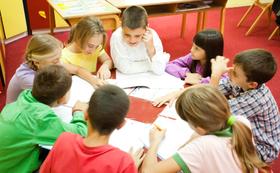For the 2025-26 school year, there are 16 online public elementary schools serving 4,456 students in Tennessee.
Tennessee online public elementary schools have an average math proficiency score of 14% (versus the Tennessee public elementary school average of 39%), and reading proficiency score of 26% (versus the 36% statewide average).
Minority enrollment is 38% of the student body (majority Black), which is less than the Tennessee public elementary school average of 43% (majority Black).
Learn more about how online public schools and online high schools work.
Best Online Public Elementary Schools in Tennessee (2025-26)
School
(Math and Reading Proficiency)
(Math and Reading Proficiency)
Location
Quick Facts
Rank: #11.
Hickman County Learning Academy
(Math: <50% | Reading: <50%)
Rank:
Rank:
9/
Top 20%10
115 Murphree Ave
Centerville, TN 37033
(931) 729-3391
Centerville, TN 37033
(931) 729-3391
Gr: 3-12 | 22 students Student-teacher ratio: 3:1 Minority enrollment: 9%
Rank: #22.
Tennessee Online Public School
(Math: 40-44% | Reading: 50-54%)
Rank:
Rank:
9/
Top 20%10
615 Mlk Jr. Blvd
Bristol, TN 37620
(423) 652-9209
Bristol, TN 37620
(423) 652-9209
Gr: 6-12 | 243 students Student-teacher ratio: 16:1 Minority enrollment: 16%
Rank: #33.
Barry Tatum Virtual Learning Academy
(Math: 30-34% | Reading: 50-54%)
Rank:
Rank:
8/
Top 30%10
351 Stumpy Ln
Lebanon, TN 37087
(615) 453-3400
Lebanon, TN 37087
(615) 453-3400
Gr: 4-12 | 113 students Student-teacher ratio: 11:1 Minority enrollment: 34%
Rank: #44.
Mcnairy County Virtual School K-12
(Math: ≤10% | Reading: <50%)
Rank:
Rank:
5/
Bottom 50%10
530 Mulberry Ave, Suite 2
Selmer, TN 38375
(731) 645-3267
Selmer, TN 38375
(731) 645-3267
Gr: K-12 | 33 students Student-teacher ratio: 8:1 Minority enrollment: 18%
Rank: #55.
Tennessee Virtual Learning Academy
(Math: ≤10% | Reading: 40-49%)
Rank:
Rank:
4/
Bottom 50%10
2002 Indian Ridge Rd
Johnson City, TN 37604
(423) 434-4900
Johnson City, TN 37604
(423) 434-4900
Gr: 3-12 | 50 students Student-teacher ratio: 17:1 Minority enrollment: 6%
Rank: #66.
Polk Innovative Learning Academy
(Math: 11-19% | Reading: 30-39%)
Rank:
Rank:
4/
Bottom 50%10
131 Stephens St
Benton, TN 37307
(423) 299-0471
Benton, TN 37307
(423) 299-0471
Gr: K-12 | 97 students Student-teacher ratio: 6:1 Minority enrollment: 7%
Rank: #77.
Bradley County Virtual School
(Math: 10-14% | Reading: 30-34%)
Rank:
Rank:
3/
Bottom 50%10
2369 Parker Street Ne, Unit 10
Cleveland, TN 37311
(423) 709-8414
Cleveland, TN 37311
(423) 709-8414
Gr: 6-12 | 137 students Student-teacher ratio: 20:1 Minority enrollment: 14%
Rank: #88.
Carter County Online Academy
(Math: ≤5% | Reading: 30-39%)
Rank:
Rank:
3/
Bottom 50%10
139 Keenburg Rd
Elizabethton, TN 37643
(423) 547-2407
Elizabethton, TN 37643
(423) 547-2407
Gr: 4-12 | 83 students Student-teacher ratio: 7:1 Minority enrollment: 3%
Rank: #99.
Putnam County Vital
(Math: 15-19% | Reading: 25%)
Rank:
Rank:
3/
Bottom 50%10
1400 E. Spring St
Cookeville, TN 38506
(931) 372-2368
Cookeville, TN 38506
(931) 372-2368
Gr: PK-12 | 106 students Student-teacher ratio: 5:1 Minority enrollment: 19%
Rank: #1010.
Tennessee Connections K-8
(Math: 13% | Reading: 24% )
Rank:
Rank:
3/
Bottom 50%10
117 Edenway Dr
White House, TN 37188
(615) 270-2431
White House, TN 37188
(615) 270-2431
Gr: K-8 | 1,487 student Minority enrollment: 41%
Rank: #1111.
Hamilton County Virtual School
(Math: 10% | Reading: 28%)
Rank:
Rank:
3/
Bottom 50%10
3074 Hickory Valley Rd
Chattanooga, TN 37421
(423) 209-8804
Chattanooga, TN 37421
(423) 209-8804
Gr: K-12 | 313 students Student-teacher ratio: 18:1 Minority enrollment: 42%
Rank: #1212.
Roane County Virtual Academy
(Math: ≤10% | Reading: 25-29%)
Rank:
Rank:
2/
Bottom 50%10
3096 Roane State Hwy
Harriman, TN 37748
(865) 717-5443
Harriman, TN 37748
(865) 717-5443
Gr: K-12 | 62 students Student-teacher ratio: 4:1 Minority enrollment: 11%
Rank: #1313.
Tennessee Connections Academy Johnson County 4-8
(Math: 14% | Reading: 21%)
Rank:
Rank:
2/
Bottom 50%10
117 Edenway Dr
White House, TN 37188
(615) 235-3672
White House, TN 37188
(615) 235-3672
Gr: 4-8 | 1,315 student Student-teacher ratio: 27:1 Minority enrollment: 38%
Rank: #1414.
Henry County Virtual Academy
(Math: ≤10% | Reading: 20-29%)
Rank:
Rank:
2/
Bottom 50%10
937 Pioneer Rd
Paris, TN 38242
(731) 243-7114
Paris, TN 38242
(731) 243-7114
Gr: K-12 | 51 students Student-teacher ratio: 3:1 Minority enrollment: 16%
Rank: #1515.
Memphis Virtual School
(Math: 2% | Reading: 17%)
Rank:
Rank:
1/
Bottom 50%10
3237 Knight Rd
Memphis, TN 38118
(901) 416-0115
Memphis, TN 38118
(901) 416-0115
Gr: 4-12 | 333 students Student-teacher ratio: 12:1 Minority enrollment: 91%
Rank: n/an/a
2181 Parker St Ne
Cleveland, TN 37311
(423) 476-0699
Cleveland, TN 37311
(423) 476-0699
Gr: K-12 | 11 students Student-teacher ratio: 2:1 Minority enrollment: 9%
Frequently Asked Questions
How many online public elementary schools are offered in Tennessee?
16 online public elementary schools are available for Tennessee students.
What is the racial composition of online public elementary schools students in Tennessee?
Tennessee online public elementary schools minority enrollment is 38% of the student body (majority Black), which is less than the Tennessee public elementary schools average of 43% (majority Black).
Recent Articles

School Vouchers: Updated Pros and Cons (2025 Review)
Comprehensive 2025 analysis of school vouchers, weighing benefits and challenges for families, funding, outcomes, and policy directions.

Benefits and Drawbacks of Homework in 2025
Explore updated 2025 insights on homework’s benefits, drawbacks, mental health impact, best practices, and policy trends in U.S. public schools.

Charter Schools vs Public Schools 2025: Key Differences & Trends
Explore updated 2025 insights comparing charter schools vs public schools, enrollment, academic outcomes, funding, and real-world examples for families and educators.





